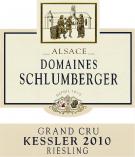History
Mentioned as early as the year 1394, the Kessler has been marketed under its own name since 1830.
Location
The Kessler grows on a sandstone soil and displays in its centre a valley that is globally facing east, south-east, which protects it from winds and cold air streams brought by the valley of Guebwiller. As a natural extension of the Grand Cru Kitterle, its subsoils are reddish over Vosgean sandstone bedrock. At its base, an outcrop of limestone results in clay soils.
Wine-making
Whole grape pressing, static racking. Fermentation in thermocontrolled tuns for 1 to 4 months. Ageing on fine lees for 8 months.
Gastronomy
Do not hesitate to associate this wine with shellfish, shrimp on skewer with Thai sauce, a lobster ragout with spices or carp fillet in Jewish style.
Serve at a temperature of 12°C.
Learn more about food & wine pairingTasting
The robe is bright yellow with green reflections, of average intensity. The disk is bright, limpid and transparent. The wine is agreeably young.
The nose is frank and pleasant with a beautiful intensity. We perceive a dominant of fruity, exotic notes, citrus, lemon, grapefruit and a fine touch of spices and ginger. Airing enhances the previous aromas and reveals an empyreumatic, smoky flint note, which express a superb notion of the terroir.
The quality of the grapes is exemplary and at this stage of maturity, already perfectly matches the terroir. The wine still needs time to open up.
The onset in the mouth is rich and fleshy, with a balanced alcohol support. The wine evolves on a medium with a frank and sharp vivacity, with a fine sparkling note. The range of flavours is still rich with fruit, citrus and lemon. The minerality is expressed with great character and elegance. The finish has good length, 8-9 caudalies and shows a clean and persistent vivacity. The balance of this wine is fleshy and incisive, a full expression of the terroir. It will be a great wine when fully mature.

















